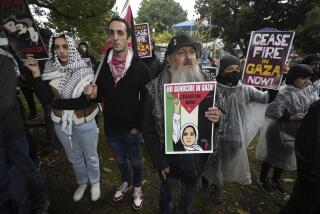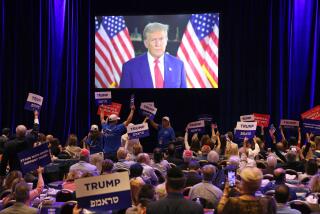The Perception of Power : JEWISH POWER: Inside the American Jewish Establishment.<i> By J. J. Goldberg (Addison Wesley: 422 pp., $25)</i>
In the dramatic prologue of “Jewish Power: Inside the American Jewish Establishment,” J. J. Goldberg describes a 1991 news conference where then-President Bush opposed a $10-billion loan guarantee for Israel’s effort to absorb Russian Jewish refugees. This moment’s historic importance is identified as “the first-ever public assault on the American Jewish community by a sitting president in the history of the republic.”
The prologue also introduces us to the object of Bush’s ire--the Jewish leadership represented by Shoshana Cardin, chairman of the Conference of Presidents of Major American Jewish Organizations, that “loose coalition of four dozen Jewish religious associations, civil rights agencies, welfare funds and fraternal societies that make up the notorious alphabet soup of American Jewish community life.” Goldberg goes on to suggest that Bush’s negative comments about pro-Israeli lobbying (the president said angrily that he was “up against some powerful political forces . . . something like a thousand lobbyists on the hill”) contributed, however slightly, toward his 1992 defeat.
Even though the president was not an anti-Semite, even though the Jews were a minuscule portion of the electorate and even though Jews had increasingly been abandoning the Democratic Party for the Republicans, Goldberg concludes that American Jews “were indisputably a powerful political force.” Yet that leads to a nagging question, one that persists throughout his book: Is there really “Jewish power” in American political life?
Goldberg quotes Abba Eban, Israel’s elder statesman and first foreign minister, who argues that “only two American Jews have ever wielded real power as Jews”--Arthur J. Goldberg (no relation to the author) and Henry Kissinger. According to Eban, American Jewry never possessed power, but merely influence, and Goldberg does not formally agree or disagree. Indeed, he finds it difficult to define the difference between “influence” and “power.”
If you are curious about America’s major Jewish organizations, their birth, their growth, their mutual as well as their internal tensions and intrigues, you are likely to find that information in this volume, along with answers to questions that never occurred to you. Moreover, if you are looking for an easily readable though very detailed report on the collective political impact of the largest Jewish community ever to live in a free country, this is also the book for you. But if you expect yet another wrestling match with the once-again popular “Protocols of the Learned Elders of Zion”--a historically bogus anti-Semitic political tract--you will be sorely disappointed.
What Goldberg does convey is a strong awareness of history: American Jewry’s involvement in politics is traced back to the inauguration of George Washington when three of the young republic’s Jewish communities sent him congratulatory letters. The president’s dutiful replies included his oft-quoted affirmation that “the government of the United States of America . . . gives to bigotry no sanction, to persecution no assistance.” Goldberg duly notes that three letters were sent when one would have been a more meaningful message from the country’s small group of Jewish citizens. And he uses the incident to illustrate the old Jewish joke “Two Jews, three opinions,” as well as the struggle by America’s Jews over 200 years to develop a central representative organization.
The need for Jews to organize for self-protection in a hostile world is underscored by Goldberg’s thumbnail sketch of Jewish history, with special emphasis on persecution from Pharaoh’s enslavement to Hitler’s Holocaust. In no way, however, does he encourage a persecution complex. While warning that “at the end of the 20th century . . . anti-Semitism was making a disturbing comeback,” he also makes the astonishing conclusion that “for the first time in their 3 1/2 centuries as a community in America--and perhaps for the first time since the dawn of the Jewish Diaspora, 2,000 years ago--the Jews had no greater enemy than themselves.”
This statement is not made with tongue in cheek, at least not entirely. Indeed, a major portion of “Jewish Power” is devoted to the successes and failures of American Jewry’s efforts to create an effective community by means of the “notorious alphabet soup” of organizations mentioned above.
We learn, for example, about the various attempts to create these “umbrella agencies,” dating from the Board of Delegates in the late 19th century and the American Jewish Committee in the early 20th to the Conference of Presidents and the Council of Jewish Federations in the latter half of this century. We learn about the tensions between Orthodox, Conservative, Reform and Reconstructionist Jews. We read very little, by contrast, about their considerable activities and accomplishments or about the importance of Jewish religious life compared to America’s other religious denominations.
Goldberg does, however, explore the commitment of American Jews to the welfare of Israel and the influence of that relationship on American politics. He poses the tantalizing question of whether Israel is important to American policy because of Jewish commitment to Israel or whether American Jews feel responsible for Israel because of their country’s commitment to it.
Another element in the author’s exploration of Jewish power is the story of the defense agencies--the American Jewish Committee, the American Jewish Congress, the Anti-Defamation League, the local community relations councils and their intended coordination through the National Community Relations Advisory Council. Goldberg also focuses on Jewish-Christian relations and the changing relationship between the Jewish and the African American communities.
Other authors have covered the same ground, but what distinguishes this book is Goldberg’s ability to give the reader a glimpse behind the scene of American Jewish politics. By relying not only on extensive study of published material but also on conversations with “insiders,” he allows us to witness some tense moments in recent American Jewish history, the near-successes of some apparent failures and successes wrested from the very edge of disaster.
Goldberg’s research and writing style are commendable. His journalistic tone is easy to digest, and eight tightly packed pages of bibliography along with 18 pages of notes--including 175 references to interviews--testify to the thoroughness of his research. Still, there are limitations. Since Jews are the only minority group shown in relationship to the American body politic, the extent of their clout may be somewhat exaggerated. If Goldberg had included comparative information about other religious and / or ethnic minorities, the reader might have been able to make a more accurate assessment of “Jewish power.”
Nevertheless, this book is an excellent source of information, a valuable addition to the literature about American Jews. At the beginning of his narrative, the author defines his overriding purpose: “Jews are invited to find out what is being done in their name. And other Americans are invited to read on and find out what their neighbors are up to.”
This reviewer can endorse Goldberg’s invitation wholeheartedly.
More to Read
Sign up for our Book Club newsletter
Get the latest news, events and more from the Los Angeles Times Book Club, and help us get L.A. reading and talking.
You may occasionally receive promotional content from the Los Angeles Times.








